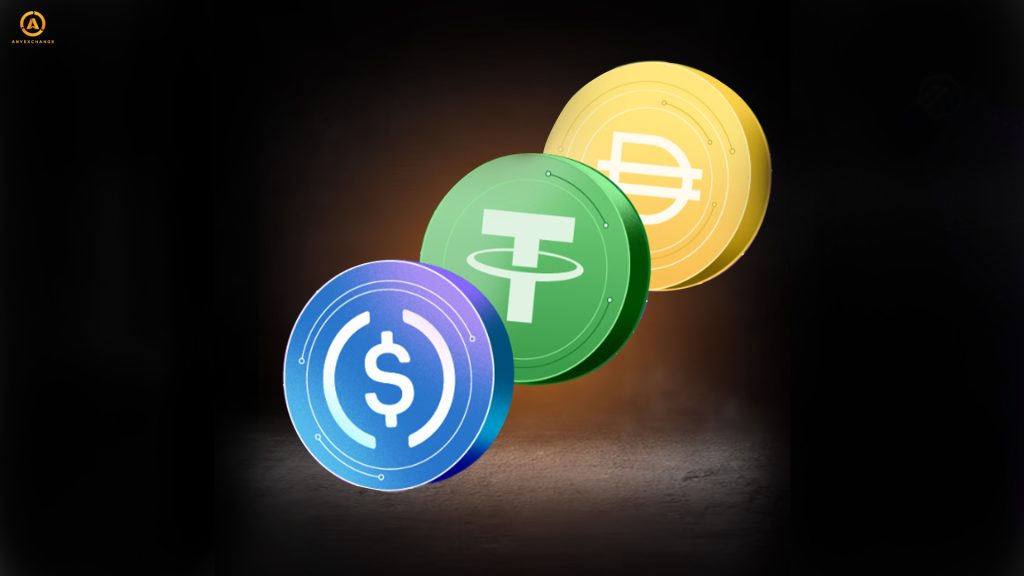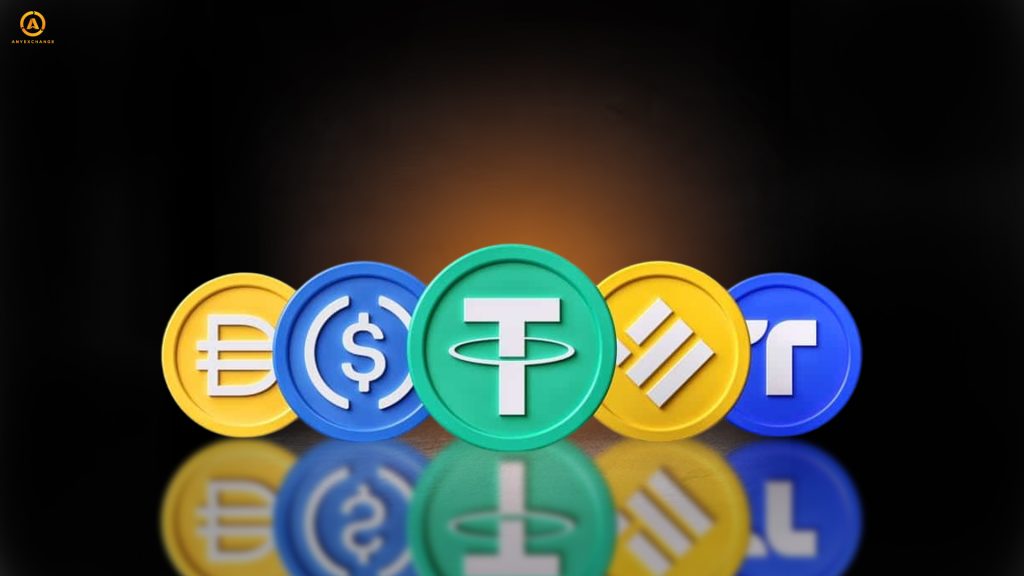
Fiat currency is legal tender, the nominal value of which is set by the state. Fiat money differs from the gold standard in that it is not backed by physical commodities. In fact, the value of fiat is determined by the authority of the government of a country.
Most often under the guise of this financial instrument are paper symbolic notes, coins not made of precious metal. Due to the use of material with no physical value, there is a huge risk of counterfeiting, and centralised control, minimal pricing transparency and high transfer fees have given rise to a new round of decentralised assets – stablecoins.
Definition of Stablecoins and their role in the ecosystem
Stablecoin is a cryptocurrency that has a stable market value and is pegged to the price of a fiat asset. It got its name from the English word stablecoin, which means ‘stable coin’ in Russian.
This type of cryptocurrency was created to combine the positive characteristics of fiat money and the advantages of a digital coin. Thus, stablecoin provides users with the necessary stability in the stock market and high transparency, as well as allows to increase the speed of transactions and reduce the amount of commission fees.
Decentralised finance has an equivalent exchange rate of 1:1 to the US dollar or other form of fiat money. The price of stablecoin may differ slightly from the set exchange rate, but it is not subject to significant fluctuations. This property defines stablecoin as the most convenient way to store virtual cash.
The emergence of the first stablecoins and their development
Loss from fluctuations is the main problem of traders, investors and other participants of the cryptocurrency exchange. The high volatility of cryptocurrency started the story of tokenisation and the emergence of a new digital coin that guaranteed stability as a reliable payment instrument.
The developer of the new crypto coin is considered to be JR Willett, who is a member of the early Bitcoin community. He was the one who proposed to bring out a cryptocurrency that would be linked to fiat assets. The first mentions of this type of digital coin were captured in the Master Coin white paper.
Stablecoins first appeared in 2014. The BitUSD coin took the lead. The released virtual currency had a peg to the dollar until 2018. The trial version had some flaws in its algorithm, due to which it failed to gain a foothold.
Later that year, an improved version called Tether was introduced with a percentage of 0.02 USDT. This coin has retained its peg to this day, despite its value fluctuations and some controversy. Following the successful start of the project, stablecoins began to develop rapidly. The range of cryptocurrencies of this kind has expanded with such coins as USDC, DAI, BUST, USDT.
Overview of the most popular steblecoins (USDT, USDC, DAI)

Among all varieties of cryptocurrency tokens, the digital coin Tether is the leader. In the circle of investors and traders, it is referred to as USDT. This digital asset is produced by the company Tether Limited. It is mainly used during the movement of digital assets between trading platforms, where you can buy and sell these types of coins. Also, USDT is increasingly used in the field of consumer payments. It is pegged to a real asset such as the dollar. Price stability is considered a major advantage of Tether, as its rate is not subject to fluctuations no matter what the market conditions are. As of January 2024, USDT is the third most popular crypto asset. It is second only to Bitcoin and Ether. The total market capitalisation at the time of publishing this article is $95 billion.
The second among the stablecoins is the USDC coin. A consortium of American companies Coinbase and Circle (CENTRE) is responsible for its release.
The cryptocurrency was introduced in September 2018. The market value of the digital asset at the end of June 2022 was $55 billion. It was possible to increase the level of capitalisation thanks to the USDC’s cash and debt securities reserves. The value of one USD COIN is $1. The level of price deviation does not exceed the indicator of 1%.
The third digital analogue of the dollar is considered to be algorithmic steblecoins DAI. A characteristic feature of these coins is their complete decentralisation. In other words, the currency does not require the deposit of an equivalent amount in the monetary unit of the United States. The issuer is the decentralised platform Maker, which introduced DAI in 2017. The issue is controlled by smart contracts that guarantee independence from intermediaries and full autonomy. DAI can be collateralised by virtual assets such as USDC, BAT, ETH, WBTC. The market capitalisation currently stands at $5.36 billion.
Stablecoins as a means of exchange and storage of value

There are several types of liquid Stablecoin, differing among themselves by stabilisation methods and other technical features.
Fiat-backed are coins that are pegged to a specific traditional currency (euro, dollar, yuan). Basically, the token has an equivalent of 1:1. Such stablecoins must necessarily have an identical amount in bank accounts. In other words, if an issuer has issued 100 thousand USDC tokens, it must have the same amount of dollars on its reserve.
Cryptocurrency-backed are coins for which other digital crypto assets act as collateral. The stability of this type is backed by smart contracts, and DeFi protocols govern.
Algorithmic – these coins are not physically backed by crypto or fiat, but function based on automated mechanisms.
The listed digital protocols are applied on cryptocurrency platforms, where trading and exchange are provided. Stablecoins are also an integral part of a decentralised exchange (DEX), as they play an important role in the formation of financial products such as derivatives, deposits, and cryptocurrencies.
Benefits of using stablecoins
Stablecoins are increasingly being used in everyday financial transactions like money transfers and buying/exchanging currencies. They have gained widespread acceptance among users due to the presence of a huge range of advantages:
Stability is the top benefit among all the pros of blockchains. The stable value makes the crypto coin the best for making transactions, storing cash and reducing volatility.
Low commission fees. Financial transactions that are conducted using digital assets are cheaper compared to international transfers and bank payments.
Accessibility. Stablecoins are territorially independent coins, thanks to which they can be used by people from all corners of the world who have access to the Internet.
Lack of management by state regulatory bodies. Stablecoin is a truly independent coin due to which its value remains unchanged.
High processing speed. Stablecoins are built on the blockchain, which allows for real-time financial manipulation. This ensures a smooth user experience, saves time and improves the efficiency of transaction execution.
Stablecoins and security – these two concepts are tightly linked. Unaltered and transparent transaction records in the blockchain make the coin unavailable to fraudsters and cyber hackers. Innovative cryptographic technologies help to increase user trust, which in turn makes it possible to perform everyday transactions securely.
Rounding out the list of benefits is absolute transparency. Crypto coin issuers value their reputation. Therefore, they conduct audits on an ongoing basis to confirm the availability of collateral.
Regulatory risks and legal uncertainty

Stablecoins, like any decentralised cryptocurrency, have certain risks when used, which may affect both users and broader financial systems.
Collateral risks. Stablecoins pegged to fiat money depend on the reliability of storage and the level of reserves. In case of a decrease in sufficiency, there is a risk of insolvency and fraud.
Regulatory restrictions. Regardless of the fact that this coin is considered to be independent, it is subject to control by some jurisdictions.
Dependence on collateral assets. Stablecoins are directly linked to collateral assets. The volatility of the underlying cryptocurrency can lead to depreciation or other problems.
Technical risks. Stablecoin is, first of all, a virtual coin, which, like all other cryptocurrencies, depends on software and smart contracts. In case of their failure, unpredictable problems may arise, which entail a loss of stability, value, etc.
Decentralised applications (dApps) can minimise risks and preserve the liquidity of tokenisation.
How stablecoins work and why dApps are needed
A dApps application is a combination of smart contracts and a user interface built on a decentralised network. They increase overall security by preventing data leakage and hacking. It also provides absolute transparency and a fixed transaction history. In addition, users are given full control over their assets.
These applications are developing and expanding rapidly. Today, the number of their varieties exceeds more than 5. The most popular and largest are DeFi and NFT decentralised finance, which allow improving existing financial systems.
Liquidity pools have also become a revolutionary idea for strengthening liquidity. They are used on the DEX decentralised exchanges.
Conclusion
The evolution of stablecoins in the context of decentralised finance has greatly simplified the handling of international transfers, made transactions cheaper, and facilitated the ability to lend and borrow without intermediaries.
Despite the overwhelming success of stablecoins in the cryptocurrency world, what remains unchanged is that a reliable cryptocurrency exchanger like AnyExchange is required for all fiat crypto transactions. Innovative equipment, a wide range of services and expert technical support allow you to make money transfers at favourable rates in real time from anywhere in the world.






